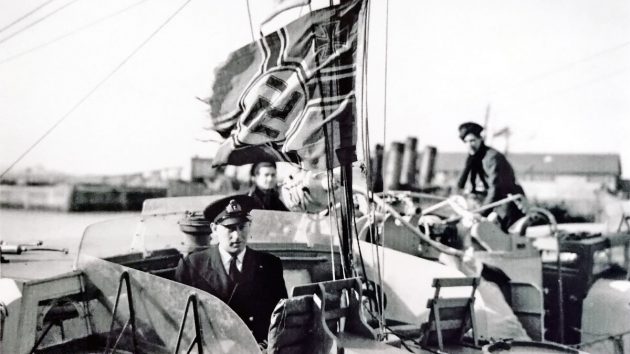With the publication of the uncensored version of We Fought Them in Gunboats, Julia Jones reflects on the book’s author, Robert Hichens, and the role he and others played in protecting vital convoy routes
Several of the World War II Coastal Force bases on the south and east coasts of England were named after stinging or biting insects: there was HMS Wasp at Dover, Bee at Weymouth, Midge Great Yarmouth, Mantis Lowestoft, Hornet at Gosport.
The best-named however was surely HMS Beehive at Felixstowe.
This was the first base on the East Coast and was chosen for its pre-existing facilities.
As well as the old Felixstowe Dock basin itself (now filled in as part of the 2012 extension of the modern container port), there was an RAF flying boat development site adjacent.
No longer in full use, it offered all the necessary infrastructure for a base – a powerful crane, engineering sheds, accommodation and quick access to the sea.
When Robert Hichens arrived there with the 6th MGB Flotilla in March 1941 he was impressed by the facilities, much less impressed by the workforce.

Before joining the Royal Naval Reserve Hichens was an accomplished yachtsman. Credit: Photos as reproduced in We Fought Them in Gunboats by Robert Hichens, published by Golden Duck Publishing (golden-duck.co.uk) in partnership with Felixstowe museum
His boat, MGB 64, had a leaking stern gland, which could potentially have been repacked with the boat in the water.
Instead, she was floated into a cradle and craned out ‘with much shouting and strife’.
MGB 64’s measurements had not been taken correctly and both propeller shafts were badly bent in the process.
As the main asset of these boats was their powerful Rolls Royce Merlin 1100hp engines, this was a disaster, as Hichens explains. ‘Within the first 17 days of our time at Beehive, we were slipped and unslipped no less than five times, in an endeavour to correct the misalignment of shafts, stern glands and P-brackets that ensued. Only a gunboat or MTB officer who has experiences of these things can appreciate fully the labour and discouragement involved in all this continual slipping; taking down the mast and aerials, removing guns, de-ammunitioning ship and so on, with no chance to get on with our training and final working up.’
Leader of the gunboat pack
Hichens, the first volunteer officer to command a gunboat, would become the most successful, influential and highly decorated officer in Coastal Forces before his death in April 1943.
In civilian life, he was a solicitor in Cornwall and had extensive experience in both dinghy sailing (International 14s) and offshore racing in the Fastnet and Channel races.
His more relevant passion was motor racing.
Every year he painstakingly stripped down, serviced and reassembled his Aston Martin, usually in the drawing room.
Hichens really understood high-speed engines and was shocked by the way he saw them being mistreated by the youthful and inexperienced RN officers.

MTBs and MGBs in Felixstowe Docks. Credit: Photos as reproduced in We Fought Them in Gunboats by Robert Hichens, published by Golden Duck Publishing (golden-duck.co.uk) in partnership with Felixstowe museum
He also understood the central importance of good maintenance teams. ‘They have all the hard work and none of the jam. They are hardly heard of and yet they form a vital part of the organisation.’
The HMS Beehive support workers would become outstanding.
A fragment of MTB 232’s war diary preserved today in the archive of the nearby Felixstowe Museum records an engine change being effected in 45 minutes and the MTB being back to sea for engine trials in just over an hour.
MTB 232 was commanded by Ian Trelawny, who’d later play a vital postwar role in the development of the Port of Felixstowe.
In June 1942 he was newly arrived from the South Coast and had been in action off Blanckenberge with the 21st MTB Flotilla, incurring significant damage to their vessels as well as human casualties.

Robert Hichens and his MGB 64 crew. Credit: Photos as reproduced in We Fought Them in Gunboats by Robert Hichens, published by Golden Duck Publishing (golden-duck.co.uk) in partnership with Felixstowe museum
Beehive’s shipwrights and engineers had started work on MTB 232 within 5 minutes of her return at 0915 and she was at sea again for trials by 12 noon, with 17 new tingles fitted as well as the replacement engine.
Clearly much had changed. It’s now possible to get some idea of the speed and scale of change from the recently ‘de-censored’ edition of Hichens’s classic book We Fought Them in Gunboats.
He’d begun writing this in the last six months of his life with the stated intention of presenting ‘as true a picture as possible’ of the life of a gunboat officer.
He holds nothing back in describing his struggles with the distant Admiralty ‘experts’ who didn’t understand the operational needs of his fast, vulnerable and (initially) under-armed craft.
He pours scorn on the copious AFOs (Admiralty Fleet Orders) which regulated their equipment, maintenance and activity without ever visiting their base or going to sea to observe them in action.
A battle on two fronts
Hichens was still writing his book when he was killed. His widow, Catherine, had the manuscript typed and sent it to the Admiralty.
Unsurprisingly they expressed little inclination to publish it.
Their initial response offers only to keep the work safe and advises Catherine that she may apply for its release ‘when hostilities are ended’.

Robert Hichens with his two sons shortly before he was killed. Credit: Photos as reproduced in We Fought Them in Gunboats by Robert Hichens, published by Golden Duck Publishing (golden-duck.co.uk) in partnership with Felixstowe museum
Which hostilities, she may have asked herself? Hichens had rarely scrupled to point out that he sometimes felt he was fighting a battle on two fronts: one with the declared enemy and the other with recalcitrant authority.
Catherine persisted and saw the 88,000-word unfinished work reduced by the censor to 55,000 words of ‘heroic’ narrative which omitted all significant technical detail as well as the stupidities, failures and disagreements.
It was still a best-seller.

The gunboat crews were vital in keeping the convoy routes open during World War II. Credit: Photos as reproduced in We Fought Them in Gunboats by Robert Hichens, published by Golden Duck Publishing (golden-duck.co.uk) in partnership with Felixstowe museum
Reinstating the original text, with the support of Robert’s younger son, Antony (aged 6 when his father died), has been a fascinating project, improved further by the decision of Trelawny’s family to agree to the publication of their father’s papers stored in Felixstowe Museum’s archive.
After his period of service at HMS Beehive Trelawny worked in wreck dispersal and salvage.
Later, he became Port Manager at Felixstowe, then a director of the Felixstowe Dock and Railway Company.
And he married June, one of the Wrens who had helped to transform onshore operations at HMS Beehive from the somewhat bad-tempered and inefficient organisation Hichens and MGB 64 had initially encountered.
Women’s work
June Trelawny (nee Wilkinson) was a 17-year-old Wren messenger.
But there were also Wrens cleaning ammunition, undertaking torpedo maintenance, operating the boom defence system, collecting and returning boats to the dock and running the 24-hour harbour service.
It need hardly be mentioned that there were Wrens operating nearby Bawdsey Radar and the essential network of Y-stations along the East Coast.

Wrens played a vital part in helping run the Coastal Force during World War II. Credit: Photos as reproduced in We Fought Them in Gunboats by Robert Hichens, published by Golden Duck Publishing (golden-duck.co.uk) in partnership with Felixstowe museum
‘Everywhere there was work to be done ashore,’ wrote Trelawny, ‘There were Wrens there to do it. There was nothing they could not tackle.’
The photo of Vicky Trout and Joan Baker towing MGB 61 out of the repair hangar with their tractors (above) was widely shared as recruitment propaganda, though neither the women nor the location were named.
When Admiral Breuning led his E-boats into Felixstowe Dock to surrender in May 1945, it was the Wrens who ferried him and his official North Sea minefield charts across to Harwich.
It would seem a pity if the memory of such extensive hands-on service is obliterated as thoroughly as the HMS Beehive site itself has been.
We Fought Them in Gunboats is published by Golden Duck Publishing, £14.99.

Buy We Fought Them in Gunboats at Amazon (UK)
Buy We Fought Them in Gunboats at Amazon (US)
Buy We Fought Them in Gunboats at Golden Duck Publishing (UK)
Buy We Fought Them in Gunboats at Waterstones (UK)
Buy We Fought Them in Gunboats at Foyles (UK)
Note: We may earn a commission when you buy through links on our site, at no extra cost to you. This doesn’t affect our editorial independence.
Enjoyed reading Gunboat crews in defence of the realm? 
A subscription to Practical Boat Owner magazine costs around 40% less than the cover price.
Print and digital editions are available through Magazines Direct – where you can also find the latest deals.
PBO is packed with information to help you get the most from boat ownership – whether sail or power.
-
-
-
- Take your DIY skills to the next level with trusted advice on boat maintenance and repairs
- Impartial in-depth gear reviews
- Practical cruising tips for making the most of your time afloat
-
-





